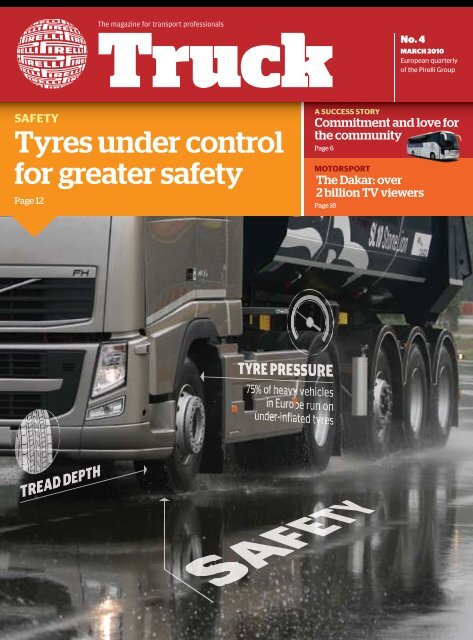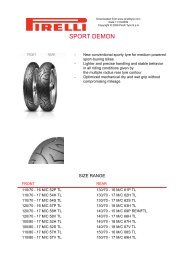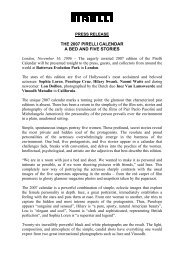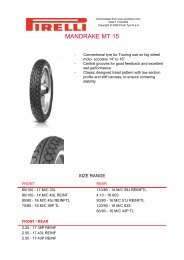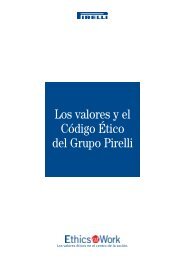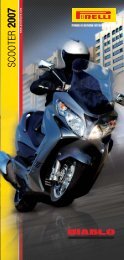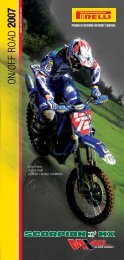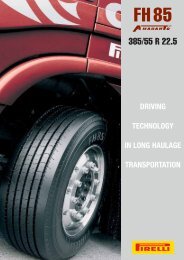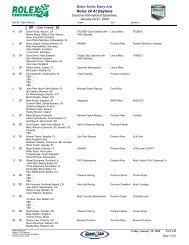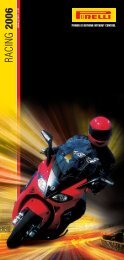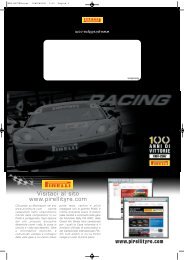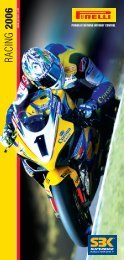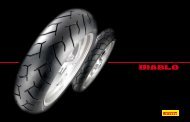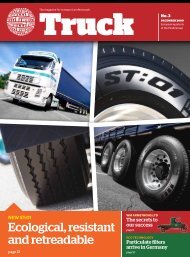Tyres under control for greater safety Tyres under control - Pirelli
Tyres under control for greater safety Tyres under control - Pirelli
Tyres under control for greater safety Tyres under control - Pirelli
You also want an ePaper? Increase the reach of your titles
YUMPU automatically turns print PDFs into web optimized ePapers that Google loves.
No. 4 MARCH 2010We seek 360°of driving <strong>safety</strong>Interview3with Alessandro Ascanelli,Director of Research & Development<strong>Pirelli</strong>’s Truck business unitHow happy are you with the resultsachieved in terms of <strong>safety</strong>, respect <strong>for</strong>the environment and per<strong>for</strong>mance?A.A. —2009 was a greatly satisfyingyear. The launch of the new FR:01in particular served to pave the way.In fact, the technological innovationbrought to the new Regional tyre hasbeen adopted <strong>for</strong> other <strong>Pirelli</strong> tyres,such as the new ST:01 semi-trailer tyreand the new 88 on-off and motorwayseries. In this same segment, the new385/65R 22.5 size <strong>for</strong> the FH88 Energy<strong>for</strong> front axles <strong>for</strong> very heavy transportprovides an optimal balance between<strong>safety</strong> and green per<strong>for</strong>mance.What does it mean <strong>for</strong> those responsible<strong>for</strong> <strong>Pirelli</strong>’s Research & Developmentto pursue <strong>greater</strong> <strong>safety</strong>?Alessandro Ascanelli —It means developinga tyre that doesn’t limit itself to respectinglaws and regulations concerningintegrity, eco-compatibility, etc., butwhich provides 360° of <strong>safety</strong> both <strong>for</strong>drivers and the world around them. Thisradically changes the way we design atyre, because it requires us to considerany and all conditions of use beyond the<strong>for</strong>mal regulatory requirements.How do you reconcile the need <strong>for</strong><strong>greater</strong> <strong>safety</strong> with the need to continueimproving environmental per<strong>for</strong>mance?A.A. —Here, too, the first step is to respectthe regulatory limits, such as requirementsrelated to noise pollutionand the use of environmentally friendlyraw materials. The elimination of higharomaticoils from tyre compounds,<strong>for</strong> example, is a huge step <strong>for</strong>ward. Butdesigning a green tyre also means driving<strong>safety</strong>, high per<strong>for</strong>mance and lowroll resistance, while helping reduce fuelconsumption. Eco-compatibility alsomeans reducing the energy needed inproduction, such as by reducing tyreweight. In this way, we not only reducethe quantity of material needed <strong>for</strong> eachtyre, but also the amount of energy andother resources needed to manufacturethem. Tyre durability is another key factor,because retreading a tyre carcass hasa lower impact on the environment thanproducing a new tyre. So to reduce environmentalimpact in all areas, we need tocontinue research in improving tyre per<strong>for</strong>mance.No. 4 — March 2010European quarterlyof the <strong>Pirelli</strong> GroupRegistered at the Court of Milann. 210 of 29.04.2009www.pirelli.comPublished by<strong>Pirelli</strong> & C. S.p.A.Istitutional and Cultural AffairsManaging DirectorAntonio CalabròEditorial CoordinatorAlessia MagistroniEditingMaura CorinaldesiWhat are your main goals inResearch & Development <strong>for</strong> thecoming years?A.A. —Our goal is always to balance allof the characteristics that a tyre needsto have in terms of per<strong>for</strong>mance, overall<strong>safety</strong> and respect <strong>for</strong> the environment,so as to gain recognition as the best onthe market.Do you agree with the proposal toadd tyre pressure to the mandatory<strong>control</strong>s to be conducted in order toimprove road <strong>safety</strong>?(see page 12)A.A. —Absolutely. It’s essential <strong>for</strong> the<strong>safety</strong> of everyone on the road. Controllingtyre pressure ensures that the tyreis used <strong>under</strong> the best operating conditions.EmailTruck.Magazine@pirelli.comEditorial OfficeVia G. Negri, 10 – Milano, ItaliaEnglish Text EditingStudio Associato BozzolaGraphicsLeftloft — www.leftloft.comPrinterArti Grafiche Mario Bazzi S.p.A.www.bazzi.it
6The magazine <strong>for</strong> transport professionalsA SUCCESS STORYCommitment, determinationand love <strong>for</strong> the communityAir Pullman: how to become the leading airport transportation company in Italywhile having funby Luca Pisciottasome creative license from time totime, such as the ticket office thatwe installed in Malpensa which ismade out of the body of a bus. We alsosometimes customize buses <strong>for</strong> sportsteams or special events, such as the bus<strong>for</strong> New Zealand’s rugby team, the AllBlacks, used during their Italian tour,which we made with the help of Ivecoand <strong>Pirelli</strong>. These are things that helpto promote the brand and set us apartfrom the competition.Aleader in its industry, AirPullman is well known inthe region of Lombardy(Italy) in particular, onthe roads that connectMilan’s three airports – Linate, Malpensaand Orio al Serio – thanks to its most famousbrand, Malpensa Shuttle.ìIndeed,everyone recognizes the company’s famousbuses bearing this historic logo.Managed by Alessandro Oldrini andhis sister Ottavia and based in SommaLombardo (in the province of Varese),the company now employs 275 people,having exceeded the size of your typicalfamily-run business some time ago.In order to better <strong>under</strong>stand the reasons<strong>for</strong> the company’s multifacetedsuccess, we met with AlessandroOldrini to ask him a few questions.Let’s start with the company’s historyand its size. How was Air Pullmanborn and how did it grow?Alessandro Oldrini —Air Pullman cameabout thanks to the <strong>for</strong>esight of mygrandfather, who, in 1949, bought thefirst bus and, right from the start, focusedall his attention on the roughly40km that separates downtown Milanfrom Malpensa International Airport.The utmost focus on the<strong>safety</strong> of passengersand workersMy father, Giovanni, then stepped in<strong>for</strong> my grandfather and was able to givebusiness a significant boost. He passedaway in 2001, when the company had76 employees and 57 buses. Since then,the company has more than tripled insize. Today, the fleet includes 25 minibuses,5 cars and 140 buses, 14 of whichare lowered <strong>for</strong> use within the airports.A very serious business overall then…A.O. —A business based on transportingpeople has to pay the utmost attentionto passenger and worker <strong>safety</strong>. However,this doesn’t prevent us from takingSpeaking of passenger <strong>safety</strong>, whatsort of training to your drivers receiveand how do you keep themmotivated?A.O. —During their first weeks on the job,our drivers are accompanied by expertcolleagues in order to facilitate the transferof in<strong>for</strong>mation on vehicles, routes andprocedures. Each driver also attends acourse to prepare <strong>for</strong> the airport licenseexam, which also requires taking an antiterrorismcourse, in order to be able todrive vehicles in the apron area and to beable to deal with various challenges thatthis job entails. In terms of motivation,drivers receive a yearly bonus based on anumber of variables, the most importantof which is per<strong>for</strong>ming above the “drivingstyle” standards, which are constantlylogged by an automatic vehicle monitoring/location(AVM/AVL) system.Safety which also entails investmentin technology and in vehicles…A.O. —The systems I spoke of enable usto constantly monitor our vehicles. Wewere the first in Italy to adopt a GPS systemwith stop certification, after completingthe authorisation process with thedata protection authority and signing
8The magazine <strong>for</strong> transport professionalsPIRELLI ECO TECHNOLOGYFeelpure A/R:the filter that cleans the cityThis particulate filter <strong>for</strong> the urban segment is a successby Davide Fedeli and Francesco CerianiThis particulate filter is areplacement muffler thatreduces particulate emissions(by as much as 95%in mass and 99% in termsof number) generated by all typesof diesel engine. When installed onEuro0, 1, 2 and 3 vehicles, it lowers particulateemissions to Euro4 and 5 levels.This means that car and truck ownersdo not have to buy new vehiclesand can continue to use the ones theycurrently own while still respectinglaws and regulations concerning trafficpollution.For city traffic, the use ofthese particulate filters requires sometechnical adaptations typical of a stopand-gocontext.This particulate filterreduces particulates byup to 95%This type of use does not enable theemission fumes to reach the temperatureneeded to burn the particulatematter that accumulates in the filter,whereas this is automatic at highspeeds and high engine loads. Havingnoted this issue, <strong>Pirelli</strong> Eco Technologynow offers a valid technical alternative,known as aided regeneration, whichwas designed and perfected specifically<strong>for</strong> city use. Take street sweepers <strong>for</strong>example. These vehicles travel at verylow speeds (as low as 3-4km/h whensweeping) and very low engine loads,so emission temperatures rarely reach200°C, which is far from the 300°Cneeded <strong>for</strong> traditional systems of burningthe particulate matter trapped in a
No. 4 MARCH 20109IBERIAN PENINSULAAND FRANCECities including Madrid,Lisbon, Oporto, Orlenas,Senlis and St. Etienne aretesting the per<strong>for</strong>manceand reliability of the A/Rsolution <strong>for</strong> buses andtrucks, from Euro0 toEuro3, <strong>for</strong> urban use.NETHERLANDSIn waste collection,150 Euro2/Euro3vehicles retrofittedwith Feelpure A/R arealready operational.In the private sector,150 vehicles havebeen retrofitted withFeelpure A/R systems,80% of which on heavydutytrucks.GERMANYOver 30% of <strong>Pirelli</strong>Eco Technology saleshave been <strong>for</strong> A/Rapplications (<strong>for</strong> lightand heavy-duty trucks).in the private sector,some 40% of sales tothe end user are A/R. Inthe Lombardy region,nearly 100% of activepublic vehicle fleets havebeen retrofitted, and alarge part of these use<strong>Pirelli</strong> filters, both thetraditional Feelpure<strong>for</strong> Euro2 vehicles andFeelpure A/R <strong>for</strong> Euro3and Euro0 with specialuses.CHINA100% of sales have beento A/R retrofit buses andtrucks <strong>for</strong> urban use.filter (during the regeneration phase).There<strong>for</strong>e, in order to properly “regenerate”filters used in urban contexts,energy needs to be added from outsidethe system.With the help of leading European partnersoperating fleets of vehicles <strong>for</strong> urbanuse and vehicle manufacturers <strong>for</strong>retrofitting and as original equipment,<strong>Pirelli</strong> Eco Technology has developedits own <strong>for</strong>m of aided regeneration. Outof these partnerships, Feelpure AR, afilter with electric resistors on the surfaceof the input port, was created <strong>for</strong>the market. Based on just two parameters(emission pressure and temperature),a <strong>control</strong> box is able to determinethe best time to use these resistors,thereby minimizing energy waste.Versatile and internationalThroughout the world, we are seeingexponential growth in awareness<strong>for</strong> environmental issues, and <strong>Pirelli</strong>Eco Technology is responding to thisthrough increased commitment andthe production of solutions <strong>for</strong> all applicationsand all engine brands. ForA successfulsolution <strong>for</strong> allapplications, fromEuro1 on up tothe more modernenginesthe issue of particulates,a challenge specific tothe city, the goal is tounite filter reliabilityand versatility <strong>for</strong> realapplications, and thisis what <strong>Pirelli</strong> has doneCity useOne example of a commercialvehicle that can takeadvantage of the filter createdby <strong>Pirelli</strong> Eco Technologywith Feelpure AR, creating a prototypethat then achieved commercial successon markets throughout the world, asthe numbers and applications demonstrate:buses, waste-collection vehicles,compactors, street sweepers, smallerengine sizes (e.g. the Daily), and fromEuro1 to more modern engine types.
10The magazine <strong>for</strong> transport professionalsTesting in the wetTest driving at the Vizzola trackSPOTLIGHTTest tracks: constantsupport in innovationFrom Italy to Brazil, specialist tracks <strong>for</strong> the severest of tests – in the wet, curving, braking… –to improve traction and <strong>safety</strong>by Maura CorinaldesiThat theory and practiceare two separatethings is something welearned back in school.Theory counts <strong>for</strong> littleif it’s not put into practice or testedby way of direct experience. This iswhy <strong>Pirelli</strong>’s two test tracks, in VizzolaTicino (Varese, Italy) and Sumaré (SãoPaulo, Brazil), are essential tools <strong>for</strong>the Group’s research and developmentcentres in Italy, Germany, Brazil,the U.S., the U.K., China, Turkey andRomania. These are the tracks onwhich the most innovative theories,plans and ideas <strong>for</strong> ever safer and betterper<strong>for</strong>ming tyres are put to the testin order to assess their feasibility, efficacyand importance.<strong>Tyres</strong> are testedin all situationsat the Vizzola andSumaré test tracksTo find out more, we have spoken withRoberto Falkenstein, Director of Research& Development <strong>for</strong> <strong>Pirelli</strong> LatinAmerica, and Fabrizio Sanvito, head oftesting <strong>for</strong> <strong>Pirelli</strong> Tyre, two professionalswho know these tracks well andknow how important they are in creatingcompetitive, safe high-per<strong>for</strong>manceproducts.Describe the two test tracks <strong>for</strong> us.Sanvito —The test track in Vizzola Ticino,near Varese (Italy), was designed and developedby <strong>Pirelli</strong> engineers in the late60s. In addition to testing in wet conditions,it features a mix of straights, curvesand rings over a total of some 260,000sq.m. Given its characteristics, the track
No. 4 MARCH 201011Vizzola test trackTesting in the wet withinthe proving groundis particularly well liked by the vehiclemanufacturers that come here to testtheir prototypes be<strong>for</strong>e putting them onthe market. I also like to emphasize thatthe Vizzola Ticino track has obtained theISO 14001 environmental certification.Falkenstein —The <strong>Pirelli</strong> Tyre ProvingGround in Sumaré, near São Paulo (Brazil),was built in 1988, some twenty yearsafter the one in Vizzola, and it is the firsttrack in Latin America to be owned by atyre manufacturer. It has a surface areaof 190,000 sq.m and characteristics thatare very similar to the track in Italy.What types of tests can you conduct?F. —The tracks enable us to recreate allpossible road conditions to test tyres <strong>for</strong>all types of use, while always paying theutmost attention to both customer satisfactionand road <strong>safety</strong>.S. —The two proving grounds are technicallyvery similar, with their leading featurebeing the ability to make most of thetrack wet in a <strong>control</strong>led manner in orderto conduct tests in wet conditions <strong>for</strong> alltest situations: braking, handling in thewet, aquaplaning, noise, vibration com<strong>for</strong>t.Which tests have a direct impact onroad <strong>safety</strong>?S. —Take braking in thewet, <strong>for</strong> example, particularly<strong>for</strong> heavyvehicles. Optimisingthis area of per<strong>for</strong>mancehas areal effect on everyday<strong>safety</strong> becauseshorter braking distances,achieved byway of better per<strong>for</strong>mingproducts, can prevent some very dangeroussituations.F. —The structure of the Sumaré trackenables us to test tyres beyond their normalusage limits, which is something thatwe hope drivers never have to do. Nonetheless,in the event it should be necessary,we want to be certain that the tyrewill respond quickly and safely, so thatthe driver can maintain <strong>control</strong> of the vehicleat all times.How many tyres do you test eachyear?F. —On the track in Brazil, we test some6,000 tyres each year.S. —<strong>Pirelli</strong> test thousands of sets of tyreseach year on the Vizzola track.Is ownership of these two provinggrounds of competitive advantage to<strong>Pirelli</strong>?S. —Of course! With the data we gatherthrough track testing, <strong>Pirelli</strong> receives constantsupport in product development,with a particular emphasis on <strong>safety</strong>and the environment, and we have theguarantee of confidentiality when testingnew prototypes. In addition, thanksto the on-board computers, the datagathered on the track is verified immediatelyon board the vehicle and then sentdirectly to the development centre <strong>for</strong>further analysis.Fabrizio SanvitoHead of Testing <strong>for</strong> <strong>Pirelli</strong> TyreRoberto FalkensteinDirector of Research & Development<strong>for</strong> <strong>Pirelli</strong> Latin AmericaF. —Sumaré gives us important competitiveadvantage that enables us to be Brazil’sleading supplier of the automotiveand motorcycle industries and of heavydutyvehicles.Thanks to the testdata, <strong>Pirelli</strong> havea competitiveadvantage inthe developmentof new tyresHow is data transferred from the testtrack to the research and developmentcentre?S. —The test data is collected and verifieddirectly on board the vehicle and, if necessary,sent directly to the developmentcentre <strong>for</strong> further analysis.F. —The Sumaré test track is connectedwith our R&D centre, and the results aresent directly in order to be analyzed byour engineers and technicians.
12The magazine <strong>for</strong> transport professionalsSAFETY<strong>Tyres</strong> <strong>under</strong> <strong>control</strong><strong>for</strong> <strong>greater</strong> <strong>safety</strong>European Commission examining proposal to mandate <strong>control</strong>ling the key <strong>safety</strong>parameters of tyres to increase road <strong>safety</strong>by Maura Corinaldesi
14The magazine <strong>for</strong> transport professionalsin the UK truck tyres can go as low as1mm. Nonetheless, tyre manufacturersrecommend replacing tyres whentread depth reaches 3mm, even thougha study has shown that only one out ofthree drivers check tread depth, whichcould have serious repercussions onvehicle and passenger <strong>safety</strong>.in the summer, which inevitable af- fects road <strong>safety</strong>. Winter tyres are specificallydesigned <strong>for</strong> use on snow, atvery low temperatures, and in a widevariety of road conditions. Their speciallydesigned tread patterns providedrivers with optimal grip in wet andsnowy conditions. The specific shapeCharter, enterprises, associations, re-search institutions, and public authoritieswishing to take action and sharebest practices in road <strong>safety</strong> will help toimprove Europe’s overall competencein this area and will give their ef<strong>for</strong>ts<strong>greater</strong> reach throughout Europe. TheCharter now has more than 1450 signatories,of these tyres also reduces the risk ofincluding the ETRMA.Properaquaplaning by moving the water that As a result, the goal of unified Europeanpasses <strong>under</strong> the tyre. In a number of road <strong>safety</strong> regulations would also leadtread depth is keyEuropean nations, such as Germany, to a harmonization of sanctions at theAustria, Switzerland and Scandinavia, European level. In fact, a comparison ofto vehicle andthere is legislation which mandates the member states in terms of road <strong>safety</strong>issues – i.e. speeding, driving while in-the use of appropriate tyres duringpassenger <strong>safety</strong>winter months, which is typically from toxicated, not using <strong>safety</strong> belts, insufficientprotection, high-risk roads, failureOctober/November to April. At theConference on Road Safety, the new to observe driving and rest times <strong>for</strong>web site http://ec.europa.eu/transport/ transport professionals, poor visibility,road_<strong>safety</strong> was launched in order toetc. – shows that there are still somedisseminate a culture of road <strong>safety</strong>.Currently available in six languages,the site provides all the in<strong>for</strong>mation Vehicle categoriesneeded to request European funding,as well as a chart of the various proceduresEuropean legislation places motor<strong>for</strong> getting a driver’s licence, the vehicles and trailers into fourmain characteristics of the roadways of broad categories.each EU Member State, and a series ofin<strong>for</strong>mation and statistics on the <strong>safety</strong>of European roads.- Actual compliance with new EU<strong>safety</strong> regulations, particularly concerninggrip in wet conditions. Tyrehomologation is a means of showingthat a tyre is suited <strong>for</strong> its intended useand that it complies with European regulations.When a tyre is in compliance,it must bear the mark of homologationon one side in order to indicate that ithas been properly tested and that itmeets legal requirements.- Using proper tyres <strong>for</strong> the weatherconditions: winter tyres duringthe winter. When roads are wet, icyand snowy, you have less grip thanGroove depthChecking tread depthEuropean Road Safety CharterThe European Road Safety Charter ismuch more than a political document.It is an invitation to take real action,to evaluate per<strong>for</strong>mance, and to constantlydefend the need to reduce thenumber of victims of traffic accidents.By signing the European Road SafetyCategory LThis category includes mopeds,motorcycles, motor tricycles,quadricycles and other smallmotor vehicles with three orfour wheels. Within category L,motorcycles are then divided intotwo groups: with or without asidecar. There is also a distinction<strong>for</strong> motor tricycles that have smallengines and slower maximumspeeds than other three-wheeledmotor vehicles.Category MThis category includes motorvehicles having at least fourwheels and <strong>for</strong> the carriage ofpassengers.Category NThis category includes vehicles<strong>for</strong> the carriage of goods, whichare divided into sub-categoriesbased on size, and includes bothtrucks and vans.Category OTrailers and semi-trailers.
No. 4 MARCH 201015Daytime running lightsAs of 2011, DRLs will be mandatoryin the EU <strong>for</strong> all newcars and small delivery vanslegislative differences from country tocountry. For example, 17 EU memberstates (i.e. Bulgaria, Denmark, Estonia,Finland, Iceland, Italy, Latvia, Lithuania,Norway, the Netherlands, Poland, theCzech Republic, Romania, Slovenia,Slovakia, Sweden and Hungary) havealready adopted legislation concerningthe use of daytime running lights(DRLs), which is to become mandatory<strong>for</strong> all new cars and small delivery vansin the European Union beginning in2011. However, it will not be necessaryto install DRLs on existing vehicles. Ofcourse, traffic laws are to be applied notonly to punish infractions, but also todiscourage them and to promote responsibledriving.Driving responsibly also means beingaware of one’s own biorhythms, and sostopping when too tired to pay properattention to the road, and maintaining aThe ETRMA is oneof the 1450 signatoriesof the EuropeanRoad Safety Chartermoderate speed. However, among driversof trucks, buses and company vehicles,these two factors continue to be afrequent cause of accidents. Tiredness,in particular, is a key factor in roughly20% of all accidents involving heavydutycommercial vehicles. Europeanlegislation governs driving times <strong>for</strong>professional cross-border transportdrivers when all or a part of the routetakes place within the European Union,which must not exceed nine hours perEuropean speed limitsHeavy trucksCountry town motor- other roadsways 2 lanes 4 lanesAustria1 50 100 80 80 trailer weight up to 750 kg.50 70 60 60 > 3,5 t. with trailer weight > 750 kg.Belgium1 50 120 90 90Denmark11 50 70* 70 70 * 80 km/h when overtaking is <strong>for</strong>biddenFinland1 50 80 80 80 max. 60 km/h <strong>for</strong> trailers without brakesFrance1towed by commercial vehiclessame as <strong>for</strong> the towing, but with the weightof the trailer included in the overall weightGermania1 50 80 80 80Italia1 50 90 70 70Luxembourg1 50 90* 75* 75*Norway 50 80 80 80 max. 60 km/h <strong>for</strong> trailers without brakestowed by commercial vehiclesCountry town motor- other roadsways 2 lanes 4 lanesNetherlands1 50 80 80* 80 * 60 km/h <strong>for</strong> multi-axle trailers and caravanmotorway 60 km/h minimumPortugal1 50 90* 80 80 * minimum 40 km/hUK1 48 96 80 96 Up to 7.5 t including load48 96 64 80 > 7.5 t including loadSpain1 50 90 80 80 road with hard shoulder ≥ 1,5 m in width50 80 70 70 10km/h less with hazardous goodsSweden1 50 80 80 80Switzerland 50 80 80 80 Maximum 60 km/h <strong>for</strong> trailers weighing > 1 tHungary 50 80 70 701 Speed limits: max 85km/h (Category N2 and N3) as per Directives 2002/85/EC and 2004/11/EC
16The magazine <strong>for</strong> transport professionalsTirednessis a key factor in 20%of all accidentsinvolving heavy-dutyvehiclesalso take a break of 45 minutes.In order to strengthen <strong>control</strong>s andincrease road <strong>safety</strong>, European legislationhas introduced the use of thedigital tachograph, which is used tomeasure speed and driving times <strong>for</strong>heavy-duty vehicles used to transportgoods and passengers.day or 56 hours per week. After driving<strong>for</strong> four and a half hours, drivers mustGrip in the wetProper tyre pressureincreases grip in both wet anddry conditionsEuropean speed limitsCommercial vehiclesCountry town motor- other roadsways 2 lanes 4 lanesAustria2 50 80 70 70Belgium2 50 90* 90 90 * <strong>for</strong> > 7,5 t.Denmark12 50 80 80 80 if < 3,5 t. car limits applyFinland2 50 80 80 80 if < 3,5 t. car limits applyFrance2 50 110 80 80 3,5 t. < P.T.A.C.3 ≤ 12 t.50 90 80 80 P.T.A.C.3 > 12 t. (Truck)50 80 60 60 P.T.A.C.3 > 12 t. (Dangerous goods)Germany2 50 no* 100* 100* < 2,8 t. * 80 km/h with trailer50 80 80* 80 2,8 to 7,5 t. * 60 km/h with trailer50 80 60 80 > 7,5 t.Italy2 50 130 90 110 light commercial vehicles (< 8 t)50 80 70 70 commercial vehicles (> 8 t.)50 100 80 80 commercial vehicles (< 12 t.) 4Luxembourg2 50 90 a 75 b 75a b 70 km/h if rain > 3,5 t.Norway 50 80 80 80 if < 3,5 t. car limits applyNetherlands3 50 80 80 80Polonia 60 130 90 110 < 3,5 t.60 90 70 90 > 3,5 t.60 80 70 80 Dangerous goodsPortugal2 50 110 80 90 < 3,5 t.50 90 80 80 with trailer, <strong>for</strong> vehicles < 3,5 t.UK2 48 96 64 80 > 7,5 t. laden weight48 112 80 96 < 7,5 t. laden weightSpain2 50 80* 70 70 * 100 km/h vehicles < 3,5 t.50 80 80 80 road with hard shoulder width ≥ 1,5 mSweden2 50 80 80 80 if < 3,5 t. car limits applySwitzerland 50 80 80 80Hungary 50 80 70 702 Speed limits: max 85 km/h (N3 Category) starting from 01/01/1995 <strong>for</strong> European Community Memberstates3 P.T.A.C.= Total Authorized laden weight4 Special vehicles max. 40 km/h in town - max. 60 km/h on roadsPublic vehiclesCountry town motor- other roadsways 2 lanes 4 lanesAustria5 50 100 80 80Belgium5 50 90* 90 90 * <strong>for</strong> > 7,5 t.Denmark15 50 80 80 80Finland5 50 100 80 100* * <strong>for</strong> authorized busesFrance5 50 110 90 100 3,5 t. < P.T.A.C.1 8 t.50 130 90 110 < 8 t.Luxembourg5 50 90 a 75 b 75 b a b 70km/h if rain, > 3,5 t.Norway 50 80 80 80Netherlands5 50 80* 80 80 *minmum 60 km/hPolonia 60 100 70 100Portugal5 50 100 90* 90* * road with hard shoulder width ≥ 1,5 m50 100 80 80UK5 48 112 80 96 leghth < 12 m48 96 80 96 leghth > 12 mSpain5 50 100 80* 80* * road with hard shoulder width ≥ 1,5m50 100 70 70Sweden5 50 90 90 90Switzerland 50 100 80 80Hungary 50 80 70 705 Speed limits: max 100 km/h (N3 Category) starting from 01/01/1995 <strong>for</strong> European Community Memberstates
No. 4 MARCH 201017INFORMATION SHEETThe digital tachographConnected to the vehicle’s sensors, this device records data on driving and rest times, speed,distance travelled, and operating faults and other anomaliesby Maura CorinaldesiMandatory from 1 October 2011All newly registered vehiclesequipped <strong>for</strong> the roadway transportof passengers and goods within theEuropean Community will need tobe fitted with this deviceAs of 1 October 2011, allnewly registered vehiclesconfigured <strong>for</strong> theroadway transport of:- goods (with capacities<strong>greater</strong> than 3.5 tonnes)- passengers (seating more than 9 people,including the driver)must be equipped with a digitaltachograph.Goal of theEuropean Commission:to increase roadway<strong>safety</strong> and improvedriver workingconditionsWhen connected to the vehicle’s sensors,the device records data on the useof the vehicle over the course of a year.Specifically, the tachograph logs andstores real-time data, such as driver activity,driving and rest times, speed anddistance travelled, operating faults andother anomalies <strong>for</strong> roughly 365 days.A record is also kept of when the data isaccessed by law en<strong>for</strong>cement.Tachograph cards allow a tachographto be used <strong>for</strong> various purposes and toidentify the person interacting with thedevice, thereby making data managementsimpler and faster.There are 4 types of card:- driver card- company card- workshop card- <strong>control</strong> cardThe driver card is kept by the driverand is much like a credit card witha microchip. It is illegal to drive a vehicleequipped with a digital tachographwithout being in possession ofa personal driver card.Company cards, on the other hand,are kept by the transport company andare used to ensure that only the companyhas access to the tachograph’sdata.A workshop card may only be requestedby authorised facilities that havebeen granted a specific certificate.Control cards are used by the policeand are the only cards that enable lawen<strong>for</strong>cement to access all data foundon the digital tachograph.The European Commission’s goal is toachieve more effective <strong>control</strong> of drivingand rest times, so as to increaseroadway <strong>safety</strong> and improve driverworking conditions.Tachograph cardsThey enable the tachograph tobe used and identify the personinteracting with itThere are four types of card:driver card, - company card,workshop card and <strong>control</strong> card
18 The magazine <strong>for</strong> transport professionalsMOTORSPORTThe Dakar in South America:over 2 billion TV viewersA popular challenge that put drivers, crews and tyres to the test in oneof the world’s most arid landsby Roberto PediconiThe world’s economic crisisdidn't stop the Dakar,whose Southern Americanversion kept fans on theedge of their seats again,this year.Beginning in Buenos Aires on 1January, the rally finished there tooon 16 January. After 9,000 kilometresof tarmac, trails and sand, crossingArgentina and Chile and racing overnearly 5,000 kilometres of exhaustingspecial stages. The challenging courserequired careful driving and the utmostfocus right to the end.For this edition, the organisers of theDakar emphasised sand. The mainsetting <strong>for</strong> this spectacular rally wasthe Atacama desert in northern Chile,one of the world’s most hostile environments,50 times drier than DeathOf the 52 truck crewsstarting the rally,only 28 reachedthe finishValley in Cali<strong>for</strong>nia with less than 3mmof rain each year – the ideal setting <strong>for</strong>dune crossings. There were five stagesin Chile, interrupted by a rest day inAntofagasta, with drivers and crewheading north over mostly off-roadterrain.And those who managed to survive theextreme temperatures of the Atacamadesert then had to deal with the Andes,which were crossed twice reaching altitudesof up to 4,000 metres.It’s no surprise then, that of the 52 truckcrews that started in Buenos Aires only28 (just 53%) reached the finish line.Even a number of the trucks equippedwith <strong>Pirelli</strong> PS22 Pista tyres had to abandonthe race due to mechanical problems,including race favourites CecoTEAM Loprais (Tatra). The BrazilianPetrobras Lubrax (Tatra), with André de
No. 4 MARCH 2010BOLIVIABRAZIL19IQUIQUEANTOFAGASTACOPIAPÓARGENTINAFIAMBALÁPARAGUAYLA SERENASAN JUANSANTIAGOSAN RAFAELLA RIOJACOLÓNCÓRDOBAURUGUAYBUENOS AIRESSANTA ROSACHILEA z e v e d oin his 23rdconsecutive Dakar rally, suffered thesame fate. By the end, however, it wasconsistency which rewarded MartinMacik and KM Team Racing (CzechRepublic), with the only LIAZ in the rally,as they achieved the highest placing<strong>for</strong> the <strong>Pirelli</strong> colours in 4th place, managingto beat one of the trucks of thepowerful TEAM Kamaz, winners of thisyear’s edition of the Dakar.Again this year, the Dakar in SouthAmerica was welcomed by the mostenthusiastic fans. Thousands travelledhundreds of kilometres to not missThe rally has beenan extremely importantopportunityto promote tourismin Argentinathe most exciting stages of the rally.Moving the Dakar from Africa to SouthAmerica was a challenge that can besaid to have been overcome in terms ofthe media, as well, in that the rally wasbroadcast to 189 countries and attracted2.2 billion viewers worldwide. Thissuccess encouraged Argentina’s ministerof tourism, Enrique Meyer, to statethat the Dakar has been the most importantopportunity to promote tourismin Argentina in the nation’s history.Indeed, passion <strong>for</strong> motorsports iscommon throughout the country.From Buenos Aires, where competitorswere greeted by the first wave of fans, toCordoba, where fans of this traditionalleg of the World Rally Championshipcame in masses, the popularity of therally remained constant.
20The magazine <strong>for</strong> transport professionalsPRODUCTSizing upthe AmarantoFH88 EnergyGreater load capacity, <strong>greater</strong> durability, fuel efficiency,<strong>safety</strong> and com<strong>for</strong>tby Valeria AiesiThis April, the AmarantoFH88 Energy will beavailable in the size385/65 R 22.5 <strong>for</strong> the steeraxles of mid- and longrangevehicles (segments H and R).This tyre is to be used in the place ofthe 315/80 R 22.5 and, given its <strong>greater</strong>load capacity, is particularly suited <strong>for</strong>vehicles that are configured <strong>for</strong> weightdistributions that are shifted more towardsthe front axle, such as refrigeratedtrucks used <strong>for</strong> the transport ofperishable goods. The larger size of theAmaranto FH88 Energy also resultsin longer tyre life and <strong>greater</strong> <strong>safety</strong>,com<strong>for</strong>t and fuel efficiency.This April, Amarantowill be available inthe size 385/65 R 22.5<strong>for</strong> steer axleson mid/long-rangevehiclesIn its second life, this size will be used onsemi-trailers, so retreadability is essential.Compared with the previous FH55,the new 385/65 R 22.5 FH88 provides:- 25% <strong>greater</strong> useful life due to both<strong>greater</strong> distance and regularity in treadwear;- 4% lower rolling resistance, whichis already within the limits that are togo into effect in 2016;- Greater <strong>safety</strong>, particularly in termsof per<strong>for</strong>mance in both dry (+10%) andwet (+8%) conditions;- Greater com<strong>for</strong>t through improvedabsorption of bumps and the eliminationof vibration;- Less noise: the 385/65 R 22.5 alreadycomplies with regulations that are to gointo effect in 2016.These improvements have been madepossible in part through the use of allof the latest innovations perfected by<strong>Pirelli</strong> engineers:- latest generation zero-degree structure(Bigiro Next) and rein<strong>for</strong>ced beadto provide <strong>greater</strong> durability andintegrity- compounds with dual-layertechnology- HEXAbead bead wire (patented by<strong>Pirelli</strong>)- the exclusive rotated shoulder ribPer<strong>for</strong>mancecomparisonThe new size provides<strong>greater</strong> tyre life, improvedper<strong>for</strong>mance in dry andwet conditions, lower rollingresistance and <strong>greater</strong>retreadabilityFH88 EnergyFH85125Life (km)Regularity in wearFive-groove treadThis tread pattern provides regularity in treadwear, driving precision and grip in the wet(patented by <strong>Pirelli</strong>) in the thread andthread pattern with five grooves (two ofwhich zigzag side grooves) <strong>for</strong> regularityin tread wear, driving precision, andgrip in both wet and dry conditions.As with other <strong>Pirelli</strong> tyres, the 385/65R 22.5 Amaranto FH88 also uses treadcompounds that are free of high aromaticoils, as required by Europeanregulations.110Dryper<strong>for</strong>mance108Wetper<strong>for</strong>mance104Rollingresistance120Retreadability
No. 4 MARCH 201021TRUCK SPEAKS WITH READERSFAQAn opportunity to answer questions about tyre useand maintenance in the transportation industryWhy is proper tyre pressure importantand how often should it bechecked?Tyre pressure does not remain constantover time, but rather tends to diminishdue to a number of factors. Proper tyrepressure is key to tyre <strong>safety</strong>, per<strong>for</strong>manceand durability. Tyre pressure thatis too low leads to overheating and consequentlyto tyre damage, reduced driving<strong>safety</strong> and irregular tyre wear. Theseshorten tyre life. Excessive pressure, onthe other hand, lowers per<strong>for</strong>mance byreducing the tyre’s contact patch withthe road, lowering driving com<strong>for</strong>t andshortening tyre life. Pressure of the tyres,including the spare, should be checkedat least once a month while the tyres arecold and corrected when necessary.When should tyres be changed?Driving <strong>safety</strong>, especially in unfavourableweather conditions, depends ona great many factors with the depth ofthe tyre tread playing an essential role.Per<strong>for</strong>mance in the wet diminishes inproportion to tread depth. Tread depthshould never be less than the prevailinglegal limit (e.g. 1.6mm in Europe), which iswhy tyres bear a tread wear indicator(or TWI) to warn when this limithas been reached. However,<strong>for</strong> <strong>safety</strong> reasons, we recommendreplacing tyreswhen tread depth approaches3mm. .Tread WareIndicatorFound onthe side ofthe tread, thisindicates whentread depth hasreached thelegal limitTread groovesTread depth affectsvehicle <strong>safety</strong>Why do tyres sometimes wearirregularly?Irregular tyre wear can be the result ofone or more mechanical or geometriccharacteristics of the vehicle that are beyondtolerance levels (alignment, camber,worn shock absorbers, air leaks, etc.)and/or of incorrect tyre pressure. Onceit has started, it’s difficult to correct, butit is possible to reduce the rate at whichthe irregular wear progresses by restoringthe vehicle to its optimal condition.There is also a type of treadwear thatis typical of the drive axis (high power/torque or use of a retarder system) thatis seen with high tread depths and whichtends to regress proportionately withtread wear.Why don’t youwrite to <strong>Pirelli</strong>Truck?Our magazine can be evenbetter through the participationof our readers.Why not tell us about you workexperience or a journey you’vemade. Is there a story you couldshare? Would you like in<strong>for</strong>mationabout <strong>Pirelli</strong> products?Interested in the digital version?Write toTruck.Magazine@pirelli.comor sign up on our web site at:http://www.pirellityre.com/truck-magazine/
22The CalThe magazine <strong>for</strong> transport professionals1985In the grand hall of a palace in Edinburgh, yellows shift andmove about. Here made of light; there marble; elsewherewood. Now a mirror. The body of a woman. A lock of hair.Unlike the black. Of this there is only one, unchanging. Asif there to hold back the yellow, keep it confined. Give itboundaries.The woman is aware of all of this. She looks down on the catwalk.Soon it will be her turn to descend the stairs and walkamidst all that yellow. Not too quickly, just enough to lift herveil slightly.She knows that it will be the black alone that gives her <strong>for</strong>m.In that great hall in Edinburgh, Norman Parkinson awaits atthe end of the catwalk. Soon he will take his camera and captureher procession, her veil fluttering as she walks. And thusthe month of August <strong>for</strong> the 1985 Calendar will be a stroke ofblack on a backdrop of yellow.


